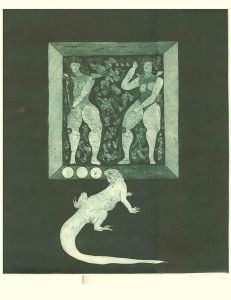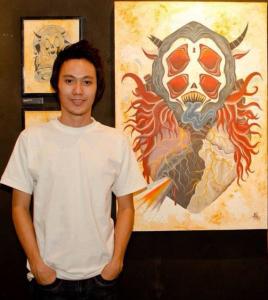There are many sayings on how art was back in the day and how freely it expresses now.
“The way that art changes depends on the environment you grew up in or with the people that surround you. It’s either you adapt what environment gives to you or the people around you, sometimes it’s just all in you,” says Christian “Tano” Panaligan.
Whether people see art as something to be nurtured or something fleeting, not everybody understands how art is formed and created. Yet as contradicting as it sounds, art is universal, and at the same time, subject to interpretation.
Finding what art is in Batangas has extended from, not just by interpreting the qualities of the art, but made it flourish in many practices.
Back in the day, art is seen as conservative or restricted. “From my perspective, back in the 70s, everything was conservative – the people, the environment, the art. Artists feel held back from executing a certain work because most people might give negative impressions,” according to Bugs Serrano.
A famous deviant is Manolito Tolentino “Toto” Mayo. Born on December 17, 1954 in Lipa, Batangas. Toto was known for his contribution as a sculptor, graphic artist, and modern poet. He was also an art professor.
Toto was believed to be the first person to contribute and influence punk in the Philippines through his looks, hairstyle and art. Though before, punk was considered as too shocking and ugly for people to adapt, it somehow made artists feel different which resulted to a unique aesthetic. Art Punk was originally a connection of punk rock music and punk subculture. It is where people have the freedom to do whatever they want, whether it be in style and looks.
 One of his more popular artworks is “Temptation”. Made in 1976, people say that it portrays trust and betrayal to a friend or your partner. In the painting, two people stand there – one with his hands tied, while the other looks away; symbolizing that they are both committed yet they are holding back to the things they really want. While the lizard is the public person who watches and observes them. The “Temptation” in Lito Mayo’s painting portrays that a person could like anything they want but they are limited with their desire to grab hold of it.
One of his more popular artworks is “Temptation”. Made in 1976, people say that it portrays trust and betrayal to a friend or your partner. In the painting, two people stand there – one with his hands tied, while the other looks away; symbolizing that they are both committed yet they are holding back to the things they really want. While the lizard is the public person who watches and observes them. The “Temptation” in Lito Mayo’s painting portrays that a person could like anything they want but they are limited with their desire to grab hold of it.
Toto was a young active artist, who experimented, collaborated and showcased his artwork in successful centers of modernist and contemporary galleries and art associations in Ermita District of Manila. Though his career was only brief, he made his art meaningful and influenced many artists by the skills he had.
“Unlike today, people are more open minded than before. There’s more freedom to express what we want to make and people start to appreciate that.” says Bugs Serrano.
“The art before and now is just the same. I think the only thing that changed was the quality or the tools artists had,” said Michael Ryan Mulingtapang, a 28-year-old contemporary artist who collaborates in tattoo designs.
In today’s art, many artists find themselves to be more expressive because it gives them the freedom to show what they really want. But for some, it’s quite difficult to be known for something majority of the population like. Some will only credit their work but others will benefit for the name they have.
 A struggling artist who found his path in the art world, 27-year-old Christian “Tano” Panaligan started drawing at a very young age. A self-taught artist, he always knew that his art will be recognized and appreciated by the likes of Batanganeuo’s and fellow Filipinos.
A struggling artist who found his path in the art world, 27-year-old Christian “Tano” Panaligan started drawing at a very young age. A self-taught artist, he always knew that his art will be recognized and appreciated by the likes of Batanganeuo’s and fellow Filipinos.
“Struggles were always there ever since I entered the art world, I didn’t know where to start since I didn’t learn art. I just sketched and painted until one or two people appreciated the work I’ve done. But even if there’s no one to appreciate the works I’ve done, I won’t stop,” he shares.
Tano didn’t bow down to the struggles he had but explored more of the art that he was best suited in. In fact, this resulted to Tano, along with other artists in Batangas, popularize an underground art movement that is best known as lowbrow or pop surrealism; an art movement with its cultural backgrounds in underground comics, punk music, and the cultures of the street.
Tano explored his art for over 4 years and he found the kind of art he was best recognizable and supported with. From the encouragement of an old friend, Gym Lumbera, “Don’t stop, just keep on doing what you do,” Tano never stopped pursuing his passion for art and also from the endless support of his best friend, Ralph Quijano. Knowing being a painter wasn’t easy, Tano supported his needs by being a prep school teacher from St. Philomena Academy, Antipolo Del Norte, Lipa City.
From drawing sketches to painting and to finally hosting his own shows like Paperview, Tano became a painter that not only caught the Batanganeuo’s attention but people from other parts of the country.
Art then and now is like being family that lives on from generation to generation. And being an artist, it takes many struggles to find where their art lies.
“Today’s art has no original form when all art has been recreated from the art before. They used it as a reference to create a new one, a new art that will be recycled and will be adapted by the next generation and that is a cycle of art,” according to Tano.
So, where does your art take you?
 WOWBatangas.com Your Source of Great News and Stories from the Province of Batangas, Philippines
WOWBatangas.com Your Source of Great News and Stories from the Province of Batangas, Philippines



